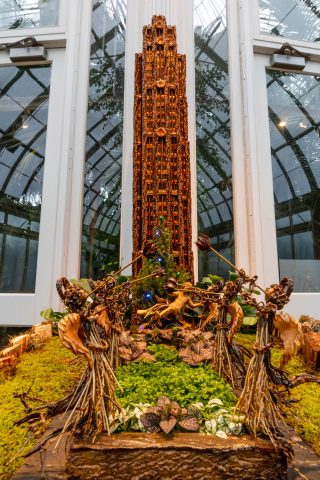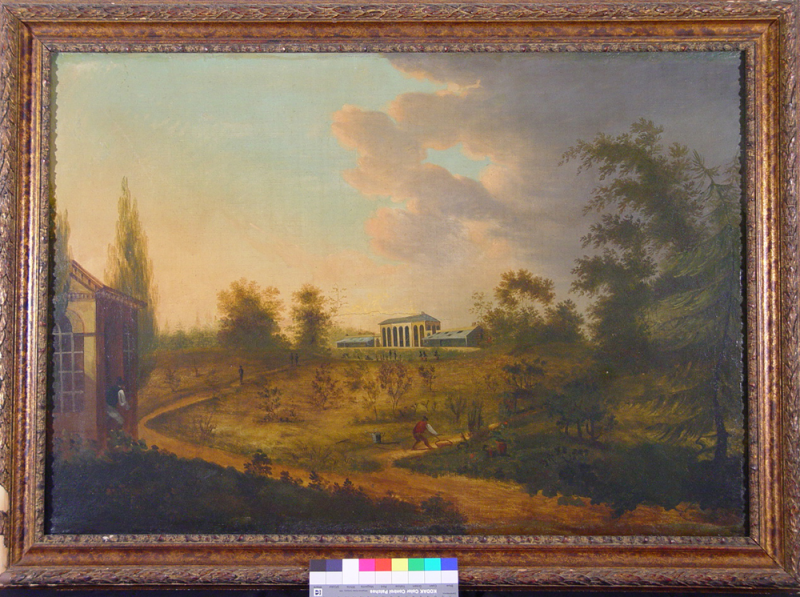Uncovering Rockefeller Center’s Historic Botanical Garden
Posted in History on November 28 2018, by Stevenson Swanson
Stevenson Swanson is Associate Director of Public Relations at The New York Botanical Garden.

Of the more than 175 New York landmarks in this year’s Holiday Train Show®, it’s particularly appropriate that Rockefeller Center’s soaring Art Deco skyscraper and other well-known features are included in NYBG’s annual display of building replicas made of bark, leaves, and natural materials. More than 200 years ago, a botanist-physician named David Hosack established one of America’s first public botanical gardens on Rockefeller Center’s site, cultivating rare and important plants on land that is now home to America’s most famous cluster of skyscrapers, shops, galleries, and, during the holidays, a towering, glittering Christmas tree overlooking the bustling plaza.
Dr. Hosack’s life and the story of his pioneering botanical garden are the subject of American Eden: David Hosack, Botany, and Medicine in the Garden of the Early Republic, by Victoria Johnson, which was a non-fiction finalist for this year’s National Book Award and was recently named one of 2018’s 100 most notable books by The New York Times Book Review.
Born in colonial New York City in 1769, Hosack came of age as the young United States began to establish itself. “It fell to Hosack’s generation to build the civic institutions that would guarantee the future health and prosperity of the Republic,” writes Johnson, a Hunter College professor who conducted much of the research for her book at NYBG’s LuEsther T. Mertz Library and William and Lynda Steere Herbarium, both of which have important collections of original Hosack material, including some of his preserved plant specimens.
One of those fledging civic institutions was the important but short-lived Elgin Botanic Garden, which Hosack founded in 1801, naming it after the Scottish city where his father had been born. It occupied 20 acres just east of the Middle Road which, as the name implies, ran up the center of Manhattan Island; it would later be rechristened Fifth Avenue. At the time, the area was mainly farmland. The northern extent of New York City lay more than three miles to the south in what today is called Lower Manhattan, which is showcased in this year’s Holiday Train Show.
The Elgin garden featured orchards of apples, pears, and apricots and a conservatory nearly 200 feet long that sheltered plants from the world’s deserts and jungles. Eventually, the garden grew to a collection of more than 2,000 plant species, the main purpose of which was scientific and educational: Hosack conducted some of the earliest systematic research in America on the chemical properties of medicinal plants, and he used his botanical garden as a living classroom where, as a professor at Columbia University, he instructed the next generation of botanists and doctors.

The Elgin Botanic Garden made Hosack famous across America and Europe, but in New York, he was also a friend and doctor of many of the city’s leading citizens. When Alexander Hamilton and Aaron Burr fought their famous duel in 1804, they chose the same attending physician, their mutual friend David Hosack.
Alas, Hosack’s ambitions for his garden outran his income, and it closed in 1811. Farmland soon gave way to the dense urban grid of the city, and 128 years later, John D. Rockefeller Jr. drove home the last ceremonial rivet in 1939 to finish the center that bears his name—and that provides stylish models for some of the best-known components of the Holiday Train Show.
In addition to the bark-and-branch replica of the 70-story Rockefeller Center skyscraper, the show includes the center’s Channel Gardens, complete with trumpet-playing angels made of dried plants, and the Statue of Prometheus, formed with gold-colored leaves. Finally, amid an ensemble of Midtown landmarks stands Radio City Music Hall, the real-life version of which was built on the site of Hosack’s conservatory.
Although the Elgin Botanic Garden is long gone, Hosack’s legacy lives on here in the Bronx. One of his students was John Torrey, a leading American botanist of the mid-19th Century who inspired the founding of the Torrey Botanical Society. An early member of the Society was Nathaniel Lord Britton, the co-founder of The New York Botanical Garden. The Holiday Train Show will run until January 21, 2019, but the inspiring example of Hosack’s life and work is never-ending.
Read more about Hosack and the Elgin Botanical Garden here.

